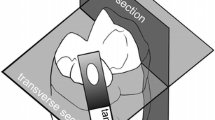Summary
The distribution of enamel tubules, the shapes and arrangements of prisms, and the orientation of crystals in ground sections from several therapsids and mesozoic mammals have been investigated by conventional and polarizing microscopy. Along each of three separate phylogenetic lines which evolved occluding teeth, there was a progressive increase in the numbers of enamel tubules. In the investigation, the arcade-shaped prisms typical of recent mammals were first seen in material from the Cretaceous period. All the enamels investigated from the Triassic contained columns of crystals, which were deduced as hexagonal. The inner ends of the crystals within each column deviated towards the center of the column. It is concluded that the existence of an interprismatic region provides the most important distinction between prismatic enamels and the hexagonal columns of crystals in the Triassic material.
Similar content being viewed by others
References
Poole, D.F.G.: The structure of the teeth of some mammal-like reptiles, Q. J. Microsc. Sci.97:303–312, 1956
Poole, D.F.G.: The formation and properties of the organic matrix of reptilian tooth enamel, Q. J. Microsc. Sci.98:349–367, 1957
Moss, M.L., Kermack, K.A.: Enamel structure in two upper Triassic mammals, J. Dent. Res.46:745–747, 1967
Moss, M.L.: Evolution of mammalian dental enamel, Am. Mus. Novit. No. 2360, 1–39, 1969
Schmidt, W.J., Keil, A.: Polarisation Microscopy of Dental Tissues. Pergamon Press, Oxford, 1971
Helmcke, J.-G.: Ultrastructure of enamel. In A.E.W. Miles (ed.): Structural and Chemical Organisation of Teeth, Vol. II, pp. 135–163. Academic Press, New York, 1967
Fosse, G., Risnes, S., Holmbakken, M.: Prisms and tubules in multituberculate enamel, Calcif. Tissue Res.11:133–150, 1973
Fosse, G., Eskildsen, O., Risnes, S., Sloan, R.E.: Prism size in tooth enamel of some late cretaceous mammals and its value in multituberculate taxonomy, Zool. Scripta7:57–61, 1978
Poole, D.F.G.: An introduction to the phylogeny of calcified tissues. In A.A. Dahlberg (ed.): Dental Morphology and Evolution, pp. 65–79. University of Chicago Press, Chicago, 1971
Osborn, J.W.: The relationship between prisms and enamel tubules in the teeth ofDidelphis marsupialis, and the probable origin of the tubules, Arch. Oral Biol.19:835–844, 1974
Osborn, J.W.: Variations in the structure and development of enamel, Oral Sci. Rev.3:3–83, 1973
Boyde, A.: The structure of developing mammalian dental enamel. In M. V. Stack, R. W. Fearnhead (eds.): Tooth Enamel, pp. 163–167. John Wright, Bristol, 1965
Poole, D.F.G., Brooks, A.W.: The arrangements of crystallites in enamel prisms, Arch. Oral Biol.5:14–36, 1961
Hopson, J.A., Crompton, A.W.: In T. Dobzhansky, M.K. Hecht, W.C. Steere (eds.): Evolutionary Biology, Vol. 3, pp. 15–72. Appleton-Century-Crofts, New York, 1969
Crompton, A.W.: Postcanine occlusion in cynodonts and Tritylodontids, Bull. Br. Mus. (N.H.) Geology (in press)
Brannstrom, M., Linden, L.A., Astrom, A.: The hydrodynamics of dentine and pulp fluid: its significance in relation to dental pain, Caries Res.1:310–317, 1967
Anderson, D.J., Matthews, B.: Osmotic stimulation of human dentine and the distribution of dental pain thresholds, Arch. Oral Biol.12:417–426, 1967
Mummery, J.H.: On the nature of the tubes in marsupial enamel, and its bearing on enamel development, Philos. Trans. R. Soc. Lond. [Biol.]205:295–313, 1914
Osborn, J.W.: Tooth sensitivity, J. Dent. Res.53:1063, 1974
Meckel, A.H., Griebstein, W.J., Neal, R.J.: Structure of mature dental enamel as observed by electron microscopy, Arch. Oral Biol.10:775–784, 1965
Osborn, J.W., Roberts, A.M.: Optical fringe effects at prism borders in human tooth enamel sections, J. Microsc.93:123–128, 1970
Osborn, J.W.: The relationship between the optical density of prism borders in dog enamel and the direction of viewing, Arch. Oral Biol.16:1055–1059, 1971
Osborn, J.W.: The mechanism of prism formation in teeth: a hypothesis, Calcif. Tissue Res.5:115–132, 1970
Osborn, J.W.: The mechanism of ameloblast movement: a hypothesis, Calcif. Tissue Res.5:344–359, 1970
Parrington, F.R.: On the upper triassic mammals, Philos. Trans. R. Soc. Lond. [Biol.]261:231–272, 1971




